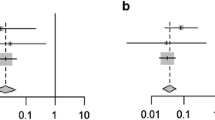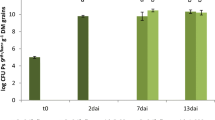Abstract
Sterol biosynthesis inhibitors that inhibit the yeast-hyphae conversion inOphiostoma ulmi suppressed Dutch elm disease development in two elm clones. After curative treatment with fenpropimorph-sulphate of 27 ‘Vegeta’ elms which had previously been inoculated withO. ulmi, 25 trees did not show disease symptoms by the end of the second season. All 41 control trees, inoculated withO. ulmi only, were clearly diseased. In an experiment with ‘Commelin’ elms three fenpropimorph salts and thiabendazole were compared. Injection of the trees three weeks after inoculation withO. ulmi gave by the end of the second season no symptoms of Dutch elm disease in any of the trees injected with fenpropimorph-phosphate or thiabendazole, and in most trees injected with fenpropimorph-acetate or-sulphate. Similar treatments with the free base of fenpropimorph and fenpropidin-sulphate were less effective due to insufficient uptake of the fenpropimorph emulsion and phytotoxicity of fenpropidin-sulphate, respectively. Injection of fenpropimorph-sulphate or thiabendazole six weeks after inoculation withO. ulmi did not result in significant differences from the control group inoculated withO. ulmi only.
Fenpropimorph-phosphate and-sulphate completely suppressed Dutch elm disease upon injection of only 7.5 or 10 g per tree (average tree diameter 28 cm). Residue analyses showed only a slow decrease in concentration of the fungicide over two growing seasons and an apparent transport into the new annual ring, other prerequisites for a possible future use for control of Dutch elm disease.
Samenvatting
De iepeziekte kan onderdrukt worden door sterolbiosyntheseremmers die de overgang vanOphiostoma ulmi van de gistvorm in de hyfevorm remmen. Aan het eind van het tweede seizoen na een curatieve behandeling van 27 ‘Vegeta’ iepen met fenpropimorfsulfaat bleken 25 bomen geen symptomen van iepeziekte te vertonen. Alle controlebomen, die alleen metO. ulmi geïnoculeerd waren, waren duidelijk ziek. In een proef met ‘Commelin’ iepen werden drie fenpropimorfzouten en thiabendazool vergeleken. De zouten werden drie weken na de inoculatie metO. ulmi geïnjecteerd. Aan het eind van het tweede seizoen vertoonden geen van de bomen die met fenpropimorffosfaat of thiabendazool geïnjecteerd waren en slechts enkele bomen die met fenpropimorfacetaat of-sulfaat geïnjecteerd waren iepeziektesymptomen. Behandelingen met fenpropimorf (vrije base) en fenpropidinsulfaat werkten minder goed door de slechte opname van de fenpropimorfemulsie en de fytotoxiciteit van fenpropidin. Injectie met fenpropimorfsulfaat of thiabendazool zes weken na inoculatie leidde niet tot significante verschillen met de controlegroep die alleen metO. ulmi geïnoculeerd was.
Een dosis fenpropimorffosfaat of-sulfaat van 7.5 of 10 g per boom met een gemiddelde boomdiameter van 26 cm bleek de iepeziekte volledig te kunnen onderdrukken. Uit residue-onderzoek bleek dat de concentratie van het fungicide gedurende de twee groeiseizoenen slechts langzaam afnam en dat het middel naar de nieuwe jaarring werd getransporteerd, twee voorwaarden voor een toepassing op praktijkschaal van fenpropimorf voor de bestrijding van de iepeziekte.
Similar content being viewed by others
References
Aronson, J.M., 1981. Cell wall chemistry, ultrastructure and metabolism. In: Cole, G.T. & Kendrick, B. (Eds), Biology of conidial fungi, Vol II. Academic Press, New York, p. 459–507.
Banfield, W. M., 1968. Dutch elm disease recurrence and recovery in American elm. Phytopathologische Zeitschrift 62: 21–60.
Barug, D., Samson, R.A. & Kerkenaar, A., 1983. Microscopic studies ofCandida albicans andTorulopsis glabrata after in vitro treatment with bifonazole. Arzneimittel-Forschung 33: 528–537.
Borgers, M., 1980. Mode d'action des imidazoles antifongiques. Revue de l'Institut Pasteur de Lyon 13: 245–252.
Borgers, M., Brabander, M. de, Bossche, H. van den & Cutsem, J. van, 1979. Promotion of pseudomycelium formation ofCandida albicans in culture: a morphological study of the effects of miconazole and ketonazole. Postgraduate Medical Journal 55: 687–691.
Borgers, M., Brabander, M. de, Bossche, H. van den & Cutsem, J. van, 1980. The effects of the new antifungal ketonazole onCandida albicans. In: Kuttin, E.S. & Baum, G.L. (Eds), Human and animal mycology, Proceedings 7th Congress ISHAM. Exerpta Medica, Amsterdam, p. 300–303.
Brasier, C.M., 1984. Inter-mycelial recognition systems inCeratocystis ulmi: their physiological properties and ecological importance. In: Jennings, D.H. & Rayner, A.D.M. (Eds), The ecology and physiology of the fungal mycelium, Symposium of the British Mycological Society. Cambridge University Press, Cambridge, p. 451–497.
Burnett, J. H., 1979. Aspects of the structure and growth of hyphal walls. In: Burnett, J.H. & Trinci, A.P.J. (Eds), Fungal walls and hyphal growth. Cambridge University Press, Cambridge, p. 1–25.
Cabib, E., Duran, A. & Bowers, B., 1979. Localized activation of chitin synthetase in the initiation of yeast septum formation. In: Burnett, J.H. & Trinci, A.P.J. (Eds), hyphal growth. Cambridge University Press, Cambridge, p. 189–201.
Cabib, E., Roberts, R. & Bowers, B., 1982. Synthesis of the yeast cell wall and its regulation. Annual Review of Biochemistry 51: 763–793.
Campana, R.J., 1978. Inoculation and fungal invasion of the tree. In: Sinclair, W.A. & Campana, R.J. (Eds), Dutch elm disease, perspectives after 60 years. Cornell University Agricultural Experiment Station, Search (Agriculture) 8, p. 17–20.
Chattaway, F.W., Holmes, M.R. & Barlow, A.J.E., 1968. Cell wall composition of the mycelial and blastospore forms ofCandida albicans. Journal of General Microbiology 51: 367–376.
Chiew, Y.Y., Shepherd, M.G. & Sullivan, P.A., 1980. Regulation of chitin synthesis during germ tube formation inCandida albicans. Archives of Microbiology 125: 97–104.
Davies, A.R. & Marriott, M.S., 1981. Inhibitory effects of imidazole antifungals on the yeastmycelial transformation inCandida albicans. Microbios Letters 17: 155–158.
Elgersma, D.M. & Steerenberg, P.A., 1978. A study of the development ofOphiostoma ulmi in elms with immunological techniques. Netherlands Journal of Plant Pathology 84: 127–133.
Gkinis, A. & Stennes, M., 1980. How to inject elms with systemic fungicides. Agricultural Extension Service, University of Minnesota, Extension Folder 504.
Greig, B.J.W. & Coxwell, R.A.G., 1983. Experiments with thiabendazole (tbz) for control of Dutch elm disease. Arboricultural Journal 7: 119–126.
Haller, I., 1980. Experimental evaluation of imidazole antifungals. In: Kuttin, E.S. & Baum, G.L. (Eds), Human and animal mycology, Proceedings 7th Congress ISHAM. Exerpta Medica, Amsterdam, p. 291–295.
Hector, R.F. & Braun, P.C., 1987. The effects of bifonazole, clotrimazole, and miconazole on chitin synthesis inCandida albicans. In: Fromtling, R.A. (Ed.), International Telesymposium on recent trends in the discovery, development and evaluation of antifungal agents. J.R. Prous, S.A., Barcelona, p. 369–382.
Kerkenaar, A. & Barug, D., 1984. Fluorescence microscope studies ofUstilago maydis andPenicillium italicum after treatment with imazalil or fenpropimorph. Pesticide Science 15: 199–205.
Kerkenaar, A., van Rossum, J.M., Versluis, G.G. & Marsman, J.W., 1984. Effect of fenpropimorph and imazalil on sterol biosynthesis inPenicillium italicum. Pesticide Science 15: 177–187.
Kerkenaar, A., Scheffer, R.J., Nielander, H.B., Brakenhoff, A.C. & Elgersma, D.M., 1986. On the chemical control ofOphiostoma ulmi with sterol biosynthesis inhibitorsin vitro andin vivo. Abstract 3C-03 of the 6th International Congress of Pesticide Chemistry IUPAC, August 10–15, 1986, Ottawa, Canada.
Lyr, H., 1987. Modern selective fungicides. Gustav Fisher Verlag, Jena & Longman Group UK Ltd., London. 383 pp.
Marichal, P., Gorrens, J. & Vanden Bossche, H., 1984. The action of itraconazole and ketoconazole on growth and sterol synthesis inAspergillus fumigatus andAspergillus niger. Sabouraudia 22: 13–21.
Mattia, E., Carruba, G., Angionella, L. & Cassone, A.J., 1982. Induction of germ tube formation by n-acetyl-D-glucosamine inCandida albicans: uptake of inducer and germinative response. Journal of Bacteriology 152: 555–562.
Miller, H.J. & Elgersma, D.M., 1976. The growth of aggressive and non-aggressive strains ofOphiostoma ulmi in susceptible and resistant elms, a scanning electron microscopical study. Netherlands Journal of Plant Pathology, 82: 51–65.
Scheffer, R.J., 1983. Biological control of Dutch elm disease byPseudomonas species. Annals of Applied Biology 103: 21–30.
Scheffer, R.J. & Elgersma, D.M., 1982. A scanning electron microscope study of cell wall degradation in elm wood by aggressive and non-aggressive isolates ofOphiostoma ulmi. European Journal of Forest Pathology 12: 25–28.
Simonetti, H., Strippoli, V. & Cassone, A., 1974. Yeast-mycelial conversion induced by n-acetyl-D-glucosamine inCandida albicans. Nature (London) 250: 244–346.
Tchernoff, V., 1965.Methods for screening and for the rapid selection of elms for resistance to Dutch elm disease. Acta Botanica Neerlandica 14: 409–452.
Trinci, A.P.J., 1978. Wall and hyphal growth. Science Progress (Oxford), 65: 75–99.
Uemura, M. & Yoshida, S., 1984. Involvement of plasma membrane alterations in cold acclimation of winter rye seedlings (Secale cereale L. cv. Puma). Plant Physiology 75: 818–826.
Author information
Authors and Affiliations
Rights and permissions
About this article
Cite this article
Scheffer, R.J., Brakenhoff, A.C., Kerkenaar, A. et al. Control of Dutch elm disease by the sterol biosynthesis inhibitors fenpropimorph and fenpropidin. Netherlands Journal of Plant Pathology 94, 161–173 (1988). https://doi.org/10.1007/BF01978005
Accepted:
Issue Date:
DOI: https://doi.org/10.1007/BF01978005




